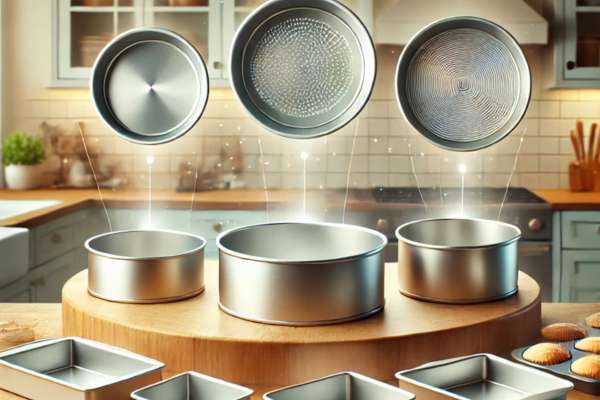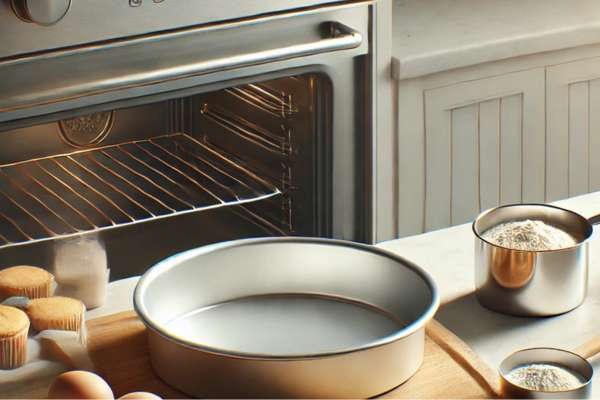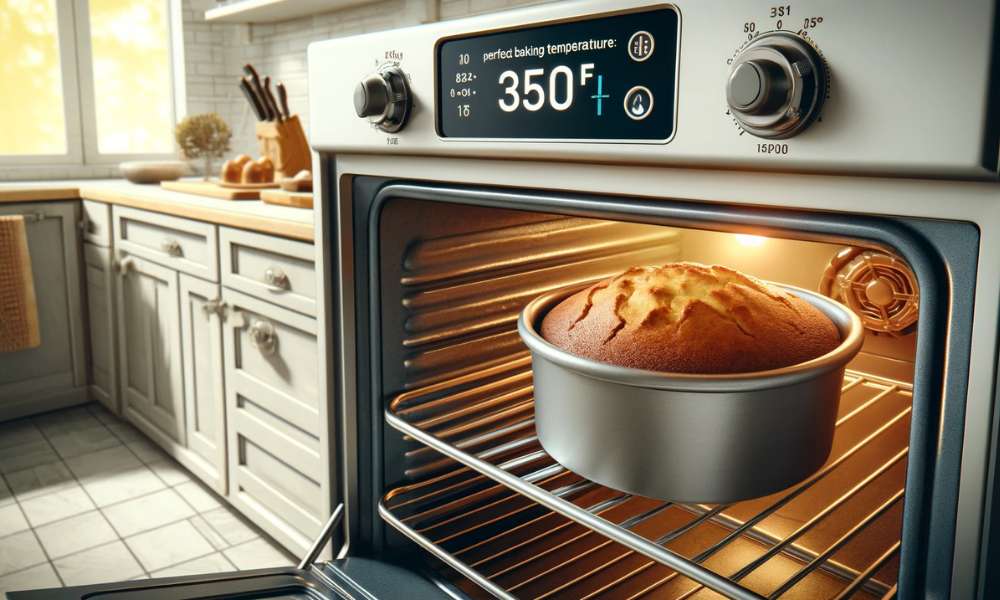Baking a perfect cake isn’t just about having the right ingredients – it’s also about choosing the right temperature, especially when using an aluminum pan. Knowing what temperature to bake a cake in the aluminum pan can make the difference between a deliciously moist cake and a dry or unevenly baked one. Aluminum pans heat up quickly and distribute heat effectively, which can impact baking times and temperatures. In this post, we’ll explore the ideal temperature settings for different types of cakes, share tips for ensuring even baking, and help you achieve a delightful, well-risen cake every time. Let’s dive into the sweet science of baking.
Understanding How Aluminum Affects Baking Temperatures

Aluminum is an outstanding heat conductor, meaning it heats up swiftly and distributes that heat evenly throughout the batter. While this provides an advantage for consistency, it also requires a lower baking temperature than other materials like glass or ceramic. If temperatures are too high, cakes baked in aluminum pans can develop a tough crust on the outside while remaining undercooked in the center. Understanding this balance is essential to avoid dry or uneven bakes.
Choosing The Right Aluminum Pan For Your Cake

Aluminum pans come in various shapes, sizes, and thicknesses. Thicker pans retain heat longer, which can alter the baking time and temperature. Meanwhile, dark aluminum pans absorb more heat, often leading to quicker browning. For optimal results, select a light-colored, medium-thickness aluminum pan to encourage an even bake without excessive browning. Always adjust the oven degree by about 10-15 degrees lower than what you’d use for glass or ceramic.
What Temperature To Bake Cake In An Aluminum Pan

Generally, cakes baked in aluminum pans perform well at temperatures between 325°F and 350°F (163°C and 177°C). Lower temperatures prevent over-browning and encourage a more even rise. A reliable guideline is to start at 325°F, especially for cakes with high sugar content, which can brown faster. Always remember to preheat the oven to ensure the aluminum pan is introduced to consistent heat from the start.
Common Temperature Guidelines For Different Types Of Cakes
Not all cakes are created equal, and temperature can vary depending on ingredients and texture. Light, fluffy cakes like angel food or sponge are best baked around 325°F to ensure a gentle, even bake. Denser cakes such as pounds or carrots may handle 350°F without issue. However, these denser cakes may still benefit from a slightly reduced temperature, especially if they are larger or thicker, to allow heat to penetrate without overcooking the exterior.
Cake Ingredients Influence Baking Temperature
Cakes rich in sugar, butter, or egg content generally benefit from lower temperatures, as these ingredients can caramelize or overcook rapidly. Sugar, in particular, accelerates browning. For recipes with substantial sugar, opt for the lower end of the temperature range to avoid premature crust formation. Cakes with acidic ingredients like buttermilk or lemon may also bake better at a lower degree, preventing over-browning.
Adjusting Temperature For Layer Cakes In Aluminum Pans
When baking multiple layers, temperature adjustments are crucial. Thin layers tend to bake faster, so lowering the temperature to 325°F can help avoid over-baking. Place each pan in the center of the oven with enough space for air to circulate, ensuring an even bake across all layers. If baking more than one layer at a time, rotate the pans halfway through to counter any hot spots in the oven.
Baking Temperature For Single-Layer vs. Multi-Layer Cakes
A single-layer cake typically requires slightly higher temperatures, around 350°F, as there’s only one level of batter to cook through. Multi-layer cakes, on the other hand, benefit from 325°F to prevent the edges from cooking faster than the center. Additionally, multi-layer cakes cool more rapidly and often yield a more tender crumb due to this gradual bake.
Troubleshooting Common Cake-Baking Problems In Aluminum Pans
Common issues in cake baking include sinking centers, cracked tops, and uneven textures. These problems are often related to temperature mismanagement. For instance, a too-high temperature may cause the outside to set before the center is done, resulting in a cracked top. Lowering the degree and extending the bake time usually helps create a smooth, even surface and prevents the cake from sinking as it cools.
Avoid Overbaking Or Undercooking Your Cake
Overbaking and undercooking are risks when using aluminum pans due to their efficient heat conduction. To avoid a dry cake, start checking for doneness a few minutes before the recommended time. Gently press the center – it should spring back if fully baked. Alternatively, insert a toothpick; it should come out with only a few moist crumbs, not wet batter.
Using an Oven Thermometer For Accurate Temperature Control
Ovens can be inconsistent, and a difference of even 10°F can affect your cake’s outcome. An oven thermometer provides a more accurate gauge, especially when baking delicate cakes in aluminum pans. Place it in the center of the oven and check the temperature before placing the shortcake inside. This step helps avoid underbaking or overbaking due to oven temperature fluctuations.
Baking Time vs. Baking Temperature Finding the Right Balance
A delicate balance exists between bake time and temperature. Lower temperatures typically call for longer baking times to ensure thorough cooking without drying out the cake. Conversely, a higher Temperature To Bake Cake In an Aluminum Pan can shorten the bake time but risk a dry or tough crumb. For the perfect texture, experiment with a slightly longer bake time at a lower degree this method provides a more tender, moist crumb.
Baking at Higher Temperatures For A Denser Cake
Dense cakes like pound cakes can withstand slightly higher Temperatures To Bake Cake In Aluminum Pan, up to 350°F, as their rich batter structure resists drying. This approach enhances the cake’s density and promotes a golden crust. However, avoid temperatures exceeding 350°F to prevent the shortcake from becoming too dry.
Cooling Down: How Temperature Affects Cake Texture As It Cools
Cooling is the final but crucial step in cake baking. Cakes in aluminum pans retain heat, which continues cooking the shortcake even after it’s removed from the oven. Transfer the shortcake to a wire rack after about 10 minutes to allow even cooling, which maintains the ideal texture. Rapid cooling in the pan can trap steam, leading to a soggy bottom or overly dense texture.
Properly Store Cakes Baked In Aluminum Pans
Once cooled, cakes baked in aluminum pans need proper storage to maintain freshness. If unfrosted, wrap the cake in plastic wrap and store it at room temperature for up to two days. Refrigerating can dry out the cake; however, a layer of frosting acts as a barrier, keeping the cake moist. For extended storage, freeze the shortcake in an airtight container.
Tips For Frosting and Decorating Cakes Baked In Aluminum Pans
Decorating a cake baked in an aluminum pan requires patience to avoid damaging the delicate crumb. A crumb coat – a thin layer of frosting – is ideal for sealing in crumbs before the final decoration. For a smoother finish, chill the cake after the crumb coat sets. If the aluminum pan has left sharp edges, gently trim them before frosting to achieve a professional look.
Conclusion
Baking a cake in an aluminum pan is a delightful endeavor that calls for precision, especially regarding temperature. With its incredible warmth conductivity, aluminum enhances even baking, provided the temperature is meticulously controlled. By understanding how temperature impacts exclusive cake sorts and following the right hints, you could create desserts that might be as beautiful in appearance as they’re in flavor. Whether you’re crafting a light, airy sponge or a dense pound shortcake, the right temperature will result in baking achievement every time.
